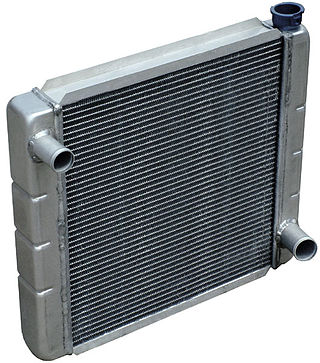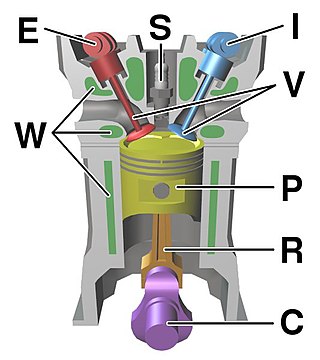Related Research Articles
A lubricant is a substance that helps to reduce friction between surfaces in mutual contact, which ultimately reduces the heat generated when the surfaces move. It may also have the function of transmitting forces, transporting foreign particles, or heating or cooling the surfaces. The property of reducing friction is known as lubricity.

A turbopump is a propellant pump with two main components: a rotodynamic pump and a driving gas turbine, usually both mounted on the same shaft, or sometimes geared together. They were initially developed in Germany in the early 1940s. The purpose of a turbopump is to produce a high-pressure fluid for feeding a combustion chamber or other use. While other use cases exist, they are most commonly found in liquid rocket engines.
A viscometer is an instrument used to measure the viscosity of a fluid. For liquids with viscosities which vary with flow conditions, an instrument called a rheometer is used. Thus, a rheometer can be considered as a special type of viscometer. Viscometers can measure only constant viscosity, that is, viscosity that does not change with flow conditions.

A boiler is a closed vessel in which fluid is heated. The fluid does not necessarily boil. The heated or vaporized fluid exits the boiler for use in various processes or heating applications, including water heating, central heating, boiler-based power generation, cooking, and sanitation.

A hydraulic fluid or hydraulic liquid is the medium by which power is transferred in hydraulic machinery. Common hydraulic fluids are based on mineral oil or water. Examples of equipment that might use hydraulic fluids are excavators and backhoes, hydraulic brakes, power steering systems, automatic transmissions, garbage trucks, aircraft flight control systems, lifts, and industrial machinery.

Fuel oil is any of various fractions obtained from the distillation of petroleum. Such oils include distillates and residues. Fuel oils include heavy fuel oil, marine fuel oil (MFO), furnace oil (FO), gas oil (gasoil), heating oils, diesel fuel, and others.

Hydraulic machines use liquid fluid power to perform work. Heavy construction vehicles are a common example. In this type of machine, hydraulic fluid is pumped to various hydraulic motors and hydraulic cylinders throughout the machine and becomes pressurized according to the resistance present. The fluid is controlled directly or automatically by control valves and distributed through hoses, tubes, or pipes.

A rheometer is a laboratory device used to measure the way in which a viscous fluid flows in response to applied forces. It is used for those fluids which cannot be defined by a single value of viscosity and therefore require more parameters to be set and measured than is the case for a viscometer. It measures the rheology of the fluid.

A mass (air) flow sensor (MAF) is a sensor used to determine the mass flow rate of air entering a fuel-injected internal combustion engine.

In geotechnical engineering, drilling fluid, also known as drilling mud, is used to aid the drilling of boreholes into the earth. Used while drilling oil and natural gas wells and on exploration drilling rigs, drilling fluids are also used for much simpler boreholes, such as water wells.
Saybolt universal viscosity (SUV), and the related Saybolt FUROL viscosity (SFV), are specific standardised tests producing measures of kinematic viscosity. FUROL is an acronym for fuel and road oil. Saybolt universal viscosity is specified by the ASTM D2161. Both tests are considered obsolete to other measures of kinematic viscosity, but their results are quoted widely in technical literature.
An Ubbelohde type viscometer or suspended-level viscometer is a measuring instrument which uses a capillary based method of measuring viscosity. It is recommended for higher viscosity cellulosic polymer solutions. The advantage of this instrument is that the values obtained are independent of the total volume. The device was developed by the German chemist Leo Ubbelohde (1877-1964).

The viscosity of a fluid is a measure of its resistance to deformation at a given rate. For liquids, it corresponds to the informal concept of "thickness": for example, syrup has a higher viscosity than water. Viscosity is defined scientifically as a force multiplied by a time divided by an area. Thus its SI units are newton-seconds per square meter, or pascal-seconds.

A liquid is a nearly incompressible fluid that conforms to the shape of its container but retains a nearly constant volume independent of pressure. It is one of the four fundamental states of matter, and is the only state with a definite volume but no fixed shape.

Radiators are heat exchangers used for cooling internal combustion engines, mainly in automobiles but also in piston-engined aircraft, railway locomotives, motorcycles, stationary generating plants or any similar use of such an engine.

Instrumentation is used to monitor and control the process plant in the oil, gas and petrochemical industries. Instrumentation ensures that the plant operates within defined parameters to produce materials of consistent quality and within the required specifications. It also ensures that the plant is operated safely and acts to correct out of tolerance operation and to automatically shut down the plant to prevent hazardous conditions from occurring. Instrumentation comprises sensor elements, signal transmitters, controllers, indicators and alarms, actuated valves, logic circuits and operator interfaces.

Wärtsilä Vasa is an engine series built by Finnish diesel engine manufacturer Wärtsilä. It was released in 1977 and remained in production until 2010. These medium speed diesels were produced in and named after Vasa, Finland. The lead designer of the first engine was Wilmer Wahlstedt. The series comprises three models, the Vasa 22, 32, and 46, with the number denoting the bore size of the engine.
Fuel viscosity control is a technique to control viscosity and temperature of fuel oil (FO) for efficient combustion in diesel engines of motor vessels and generators of oil-fired power plants.

An internal combustion engine is a heat engine in which the combustion of a fuel occurs with an oxidizer in a combustion chamber that is an integral part of the working fluid flow circuit. In an internal combustion engine, the expansion of the high-temperature and high-pressure gases produced by combustion applies direct force to some component of the engine. The force is typically applied to pistons, turbine blades, a rotor, or a nozzle. This force moves the component over a distance, transforming chemical energy into kinetic energy which is used to propel, move or power whatever the engine is attached to.
The mini-rotary viscometer is a device used to measure the pumpability of an engine oil at low temperatures. Engine oils must meet viscometric standards including those determined by the MRV in order to be classifiable within SAE J300 viscosity grades. The requirement was added after the winters of 1980-81 and 1981-82 caused major pumpability field problems in the US and Europe.
References
- ↑ Marine Auxiliary Machinery. Elsevier. 1998-10-20. ISBN 9780080511030.
- ↑ "Fuel oil viscosity explained - The need to regulate viscosity in marine engines". www.brighthub.com. Archived from the original on 2009-07-17.
- ↑ "Unknown".[ permanent dead link ]
- ↑ "Unknown".[ permanent dead link ]
- ↑ "Zeer grote brand verwoest bedrijfspand Dordrecht | Binnenland | de Volkskrant". www.volkskrant.nl. Archived from the original on 2016-03-04.
- ↑ "VAF | Home" (PDF).
- H. D. McGeorge. Marine Auxiliary Machinery, Butterworth Heinemann, 1999. ISBN 978-0-7506-4398-6, ISBN 0-7506-4398-6